Primate ecology is the study of the relationship between primates and their environment. Their environment includes not only the physical environment (e.g., trees, water, weather) but also the other animals in the environment, including other non-human primates and even humans. Why should we care about primates and their ecology? Remember that evolution is always environmentally dependent, so the environment is the main thing that we have to consider when examining a primate, its biology, and behavior. Also, keep in mind that primates are not only affected by their environments, they affect their environments as well (by eating plants and insects, dispersing seeds, etc.).
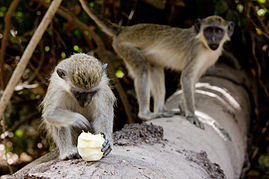
Figure \(\PageIndex{1}\) - Monkey feeding
There are two primary environmental factors that primate ecologists focus on: Food and Predators.
1) Food
- Primatologists (scientists who study primates) examine the quality, quantity, and distribution of food in a primate's environment.
- Why? Because food = babies. This means that those individuals who acquire more high-quality food more efficiently are likely to have more offspring and therefore will be more evolutionarily successful.
- This pressure is greater for females than for males, because of the biological costs associated with reproduction (reproductive asymmetry). Remember that primates spend a very long time as dependent nursing infants, so primate mothers have a heavy burden when caring for them (the only exceptions are some New World monkeys: the father cares for the infants, but the mother still nurses them).
2) Predators
- Primatologists also examine the types and distribution of potential predators in a primate's ecosystem.
- Why? Because no one wants to get eaten, right? Those who can most efficiently and effectively avoid predation are likely to have more offspring and therefore will be more evolutionarily successful.
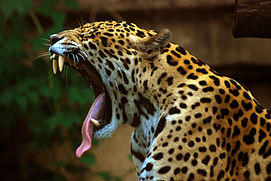
Figure \(\PageIndex{2}\) - Jaguar
Primatologists also look at other environmental factors, such as:
- weather
- the distribution of water
- the distribution of sleeping sites, and
- the primate's relationships with other individuals within their social group, other groups of their own species, and other species (including humans).
Food
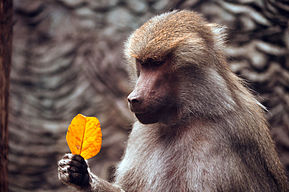
Figure \(\PageIndex{3}\) - Baboon examining a leaf
Most primates are herbivores (they eat plant foods) and are fairly generalist in their dietary habits. Some primates are omnivores and eat lots of things (plant and animal). However, some primates are more specialized.
- Folivores: eat mainly leaves.
- Frugivores: eat mainly fruit.
- Insectivores: eat mainly insects.
- Gummivores: eat mainly tree sap.
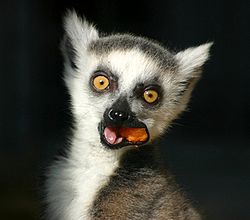
Figure \(\PageIndex{4}\) - Lemur eating fruit
One of the challenges that primates face in their day-to-day life is a type of evolutionary arms race they have with their food. Some food items, like fruit, "want" to be eaten. In other words, it's evolutionarily advantageous for a fruit to be eaten by a primate, who then carries the fruit's seeds far away from the parent plant in its stomach, to deposit them elsewhere. The fruit benefits from this seed dispersal, thereby limiting competition between the parent plant and its offspring. This is one of the hypothesized reasons that fruits have high sugar or fat contents, to make them attractive to seed dispersers, such as primates and birds.
However, some food items, like leaves, don't "want" to be eaten. It's not evolutionarily advantageous for a plant to be stripped of its leaves. A leafless tree would not be able to perform photosynthesis and would promptly die. This is why plants have developed certain chemicals, called secondary compounds or antifeedants, in their leaves. These chemicals make the leaves unpalatable or indigestible to primates. In these cases, scientists have determined that primates have developed behavioral methods to avoid consuming antifeedants. For example, most leaf-eating monkeys prefer to eat young leaves, which are visually identifiable (either lighter in color or a different color) and higher in nutrients and lower in indigestible fiber and antifeedants, than mature leaves.
Not only have primates developed behavioral strategies to meet these challenges, some primates have evolved different types of color vision in order to forage for food and other primates have developed specialized digestive systems to deal with low-quality (high-fiber, high-antifeedant) foods.
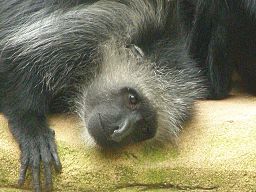
Figure \(\PageIndex{5}\) - Black and white colobus monkey resting
Activity budgets
How a primate spends its time is called its activity budget. These are comprised of the major categories of:
- foraging/feeding
- social behavior
- locomotion/traveling, and
- resting/sleeping
Why should we care about activity budgets?
Examining a primate's activity budget gives primatologists a good idea of how that particular primate (or primate group) "makes a living". For example, if squirrel monkey (pictured right) Group A spends 30% of its time foraging and squirrel monkey Group B spends 40% of its time foraging, then one can assume that there is something going on that is causing the difference. One can form possible hypotheses such as: Group B is larger than Group A and has more mouths to feed and therefore has to spend more time looking for food to feed them OR Group B has less food in its area than does Group A and so has to spend more time searching for it.
Remember also that if a primate has to spend more time eating or moving around in order to find something to eat, then they are having to spend less time either resting or socializing. Primates only have a finite amount of time in their day, so they have to maximize the use of it the best they can within their environmental parameters.
Activity budgets denote when a primate is "making a living":
- Diurnal: active during the day. Most primates are diurnal.
- Nocturnal: active during the night.
- Crepuscular: active during dawn and dusk. Ring-tailed lemurs (pictured below left) have this activity pattern.
- Cathemeral: active during irregular periods during day and night. Black lemurs (pictured below right) are one of the few primate species who have this activity pattern.
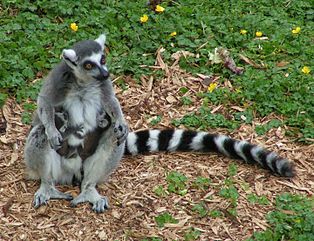
Figure \(\PageIndex{6}\) - Ringtailed lemur
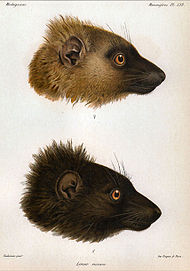
Figure \(\PageIndex{7}\) - Black lemurs
Note that these activity patterns are not hard and fast rules. As with diet, there is a lot of variation in how flexible a particular species (or group within a species) is when it comes to their activity patterns. For example, although traditionally thought of as strictly nocturnal, the activity patterns of owl monkeys have been found to be highly sensitive to environmental factors such as temperature and amount of moonlight.
Food and Feeding Competition
One of the main factors that affects a primate "making a living" is feeding competition (competing with others for food).
There are two groups that a primate competes with;
- the other primates in its social group (AKA within-group competition)
- primates (of the same species) in other groups (AKA between-group competition)
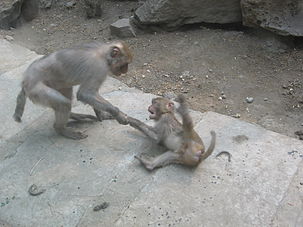
Figure \(\PageIndex{8}\) - Macaques fighting
There are also two types of competition. The type of competition prevalent in a situation depends on the quality and quantity of food available in the environment.
- Scramble competition: happens when there is a lot of low quality food. This is more common for leaf-eating primates, because trees tend to have large quantities of edible leaves (although some types, such as young leaves, may be preferable to others). It's an indirect competition in which whoever finds food faster or eats faster gets more food than do other individuals.
- Contest competition: happens when there is a small amount of high quality food. This is more common for fruit-eating primates, because a fruiting tree has a limited amount of high-quality fruit. It's a direct competition, where certain individuals (stronger, higher social status) get more food than do other individuals via squabbling or fighting.
In total, one can have:
- within-group scramble competition
- within-group contest competition
- between-group scramble competition, and
- between-group contest competition.
Feeding competition can be severe and have serious effects on the health, well-being, and reproductive capacities of primates. In other words, it has a direct effect on their evolutionary fitness. As expected, primates demonstrate a lot of behavioral strategies to deal with the feeding competition they face. For example, a group with high scramble competition may spread out more when feeding so as to access more resources OR in a group with high contest competition, some individuals may form coalitions in order to "gang up on" other primates to take their food.
Spatial use: home ranges and territories
The area that a primate uses is its home range. The part of the home range that's used most often is the core area. Some species, such as snub-nosed monkeys, have very large home ranges (32 sq. km) and other species, such as the pygmy marmoset, have very small ones (0.003 sq. km). A primate's home range has to contain all of the resources it needs in order to survive (food, water, sleeping sites, etc.). The home ranges of different primate groups often overlap, sometimes only a little, but sometimes a lot. If the home range is physically defended, it's a territory. Chimpanzees are famous for their territorial conflicts, which are so organized and violent that scientists have begun calling it "warfare".
Primate Behavior
As noted in a previous section (The Modern Non-Human Primates), one of the fundamental traits that primates share is that we are social creatures. All primates share some form of social structure with others of their own species, whether that be in a large permanent social group or as an individual who has repeated short-term interactions with others. The social relationships that primates have with other members of their own species have a huge impact on the individuals involved and are incredibly important to their health, well-being, and reproductive success. Therefore, the study of primate social behavior has been a focus of primatologists for the last 50 years.
Primate behavior studies come in three formats:
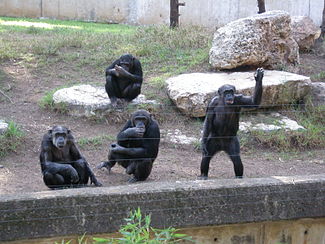
Figure \(\PageIndex{9}\) - Chimpanzees in captivity
- Captive: The animals are in captivity. Variables are easy to control in these situations (for example, the number of individuals in a group or food availability) and the primates are easier to observe at close-range. However, because of the artificiality of the situation, the primates may not be exhibiting normal behavior.
- Semi-captive (AKA semi-free-ranging): The animals are captive, but in a very large area like an island or a fenced-in compound. Variables are still relatively easy to control and the primates are easier to observe (than in the wild). The primates tend to exhibit more natural behavior patterns in this type of setting than when compared to a completely captive situation.
- Free-ranging: The animals are living in the wild, in their natural environment. This is the most logistically difficult type of primate study. The animals are more difficult to observe (often requiring a habituation period to get them accustomed to the presence of observers). However, the primates are most likely to perform their normal array of behaviors in this type of study.
Social structure: the "whys" and the "hows"
The basic premise of why primates have certain social behaviors is due to reproductive asymmetry. Remember (from "Food", on this page) that females are under a lot more pressure than males to forage effectively because of the biological pressures they're under (due to the burden of reproduction). It is precisely this inequality that causes the sexes to have different evolutionary priorities:
- For females, their priority is food. Females can only reproduce at a certain rate, due to the length of time it takes to be pregnant, raise an infant to independence, and have their bodies recover to do it all over again. Access to lots of good quality food through little effort is the key to accomplishing this task.
- For males, their priority is finding mates. Males can reproduce at a much faster rate than can females. The only real constraint on their reproductive rate is how frequently they can get fertile females to mate with them.
So, primate social structure works like this:
- male distribution follows how the females distribute themselves, and
- the females distribute themselves depending on how the food is laid out in their environment.
Social groups have two immigration/emigration patterns:
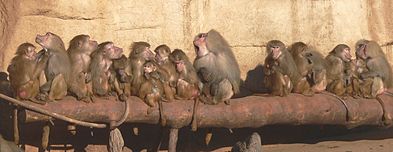
Figure \(\PageIndex{10}\) - Baboon social group
Female philopatry:
- Females do not emigrate from their birth group at sexual maturity.
- Males usually emigrate from their birth group at sexual maturity.
- Females form the core of the group, are biologically related, and have tight social bonds (often exhibited through social cooperation and grooming: seen in these baboons, pictured right). Males do not have much in the way of positive social relationships .
- This is the most common form of social system in primates.
Male philopatry:
- Males do not emigrate from their birth group at sexual maturity.
- Females usually emigrate from their birth group at sexual maturity.
- Males form the core of the group, are related. and have tight social bonds. Females do not have much in the way of positive social relationships.
- This type of social system tends to happen when resources are widely dispersed, so females are widespread and difficult for the males to consistently access (as in the spider monkey, pictured right).
Social strategies

Figure \(\PageIndex{11}\)
In order to achieve their priorities, male and females must utilize certain social strategies to gain success.
Dominance
- As with chickens, primates have a "pecking order" or dominance hierarchy in their social groups.
- One's position in the dominance hierachy often gives them access to preferred resources, including not only food and mates, but other resources such as sleeping sites and water.
- Sometimes dominance hierarchies are determined through fighting, but more often they are sorted out through a series of aggressive/submissive non-contact interactions, such as approach/avoidance, facial expressions, and body postures. Primates try to avoid direct aggressive contact in an effort to avoid risk of bodily harm.
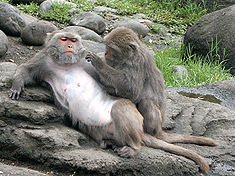
Figure \(\PageIndex{12}\) - Macaques grooming
Cooperation
- Dominance hierarchies aren't completely linear. One's rank in the hierarchy often depends on who they can get to cooperate with them during conflicts. For example, Monkey 2 may be submissive to Monkey 1 when alone, but when her buddy Monkey 3 is around, the two of them cooperate and chase Monkey 1 away from food together. Therefore, Monkey 2's position in the dominance hierarchy is situationally dependent.
- These cooperative relationships are usually between relatives. In male philopatric groups, they're usually brothers. In female philopatric groups, it's often mother-offspring or siblings.
- The relationships are cultivated through affiliative behaviors, such as play, grooming, and other forms of body contact (e.g., hugging). So, primates practice You scratch my back, I'll scratch yours both literally and figuratively.
VIDEO: How bonobos use play as a tool
Why be in a social group?
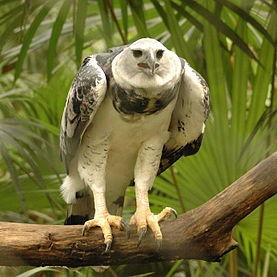
Figure \(\PageIndex{13}\)
So, why would a primate choose to be in a social group if it is just one big mess of food competition, mate competition, and political posturing? Well, because there are benefits, of course!
Living in a social group:
- provides access to mates. While there is, of course, competition for mates within the group, a social group ensures that there are at least mates available to fight over.
- provides more eyes looking for food and more brains remembering where food is in the ecosystem
- provides anti-predator defense
- There are more eyes on the lookout for predators.
- An additional anti-predator benefit is known as "The Selfish Herd" (AKA safety in numbers). It basically comes down to "you don't have to run faster than the predator, just faster than the other guy".
- Some social groups will "mob" predators and drive them away. This only works on smaller predators, especially those who rely on surprise attacks (such as the Harpy Eagle, pictured right).
Types of primate social groups
Solitary:
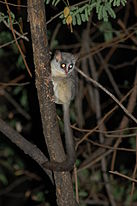
Figure \(\PageIndex{14}\) - Galago
- Males are alone most of the time, except when seeking out mates. Females live with their dependent offspring.
- One male will have territorial overlap with several females.
- Some prosimians have this social system (like the galago, pictured right).
Monogamy:
.jpg?revision=1)
Figure \(\PageIndex{15}\) - Titi monkey
- A social group is comprised of a male, a female, and their dependent offspring.
- This is also called "pair bonded".
- This is common in New World monkeys (for example, titi monkeys, pictured right) and the "lesser apes" (siamangs and gibbons).
Single-male multifemale:
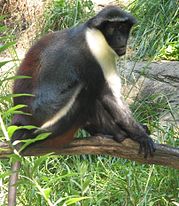
Figure \(\PageIndex{16}\) - Diana monkey
- A social group is comprised of one adult male, several (to many) adult females, and their dependent offspring.
- Males that don't belong to a social group may either live alone or in multimale (bachelor) groups that have no females.
- It's a difficult life for the resident male in these social groups, because not only did he have to fight his way into the group (either driving the previous resident male out or stealing females from another male), he has to continually fight to keep other males out of his group, while keeping the females in the group.
- When males take over groups, some may commit infanticide (killing the previous resident male's infants).
- This is a common social group in Old World monkeys (like the Diana monkey, pictured right)
Multimale-multifemale
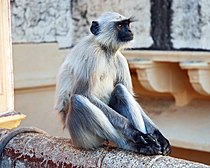
Figure \(\PageIndex{17}\) - Hanuman langur
- A social group is comprised of more than one adult male, more than one adult female, and their dependent offspring
- In these groups, in order to have preferential access to females, males will form dominance hierarchies or develop biological characteristics that the females find attractive. For example, during the mating season, squirrel monkey males begin storing large amounts of water and fat on their bodies.
- Some species (such as Hanuman langurs - pictured right) have both single-male and multimale multifemale social groups in the same population.
Fission-fusion
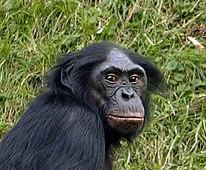
Figure \(\PageIndex{18}\) - Bonobo
- In this situation, individuals belong to a large group called a community. Each community has a home range and consistent community membership. Within the community, individuals form temporary foraging groups called parties. Parties have an unpredictable membership. So, on any given day (or even part of a day), one cannot predict who will be foraging with whom.
- Females always travel with their dependent offspring.
- Sometimes males form partnerships and forage together.
- This type of social group is thought to have been an adaptation to environments with patchy, unpredictable fruit availability.
- It's found in chimpanzees, bonobos (pictured right), and spider monkeys.
Single-female multimale
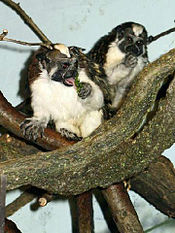
Figure \(\PageIndex{19}\) - Tamarins
- A social group is comprised of one adult female, more than one adult male, and their dependent offspring.
- This is rare in primates.
- Found in marmosets and tamarins (pictured right), this type of social system is thought to be an adaptation to the twinning (giving birth to twins) that it common to these small primates. The males carry the dependent infants.

















.jpg?revision=1)



